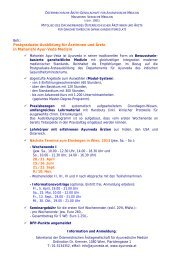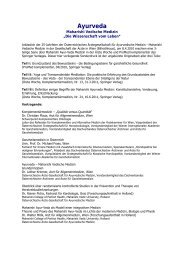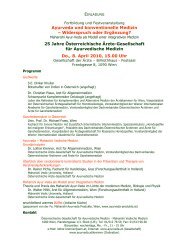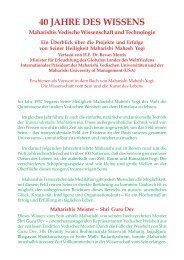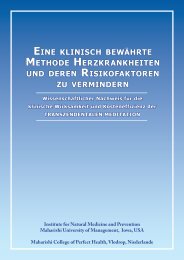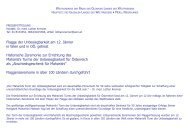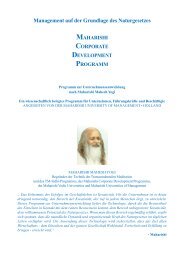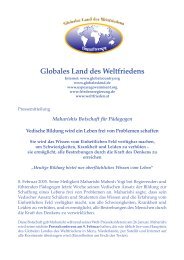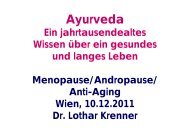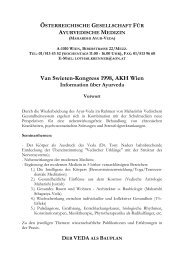Summary of Research Findings
Summary of Research Findings
Summary of Research Findings
Create successful ePaper yourself
Turn your PDF publications into a flip-book with our unique Google optimized e-Paper software.
Antioxidant <strong>Research</strong> (continued)<br />
8. Title<br />
Effect <strong>of</strong> Herbal Mixtures MAK-4 and MAK-5 on Susceptibility <strong>of</strong> Human LDL to Oxidation<br />
Publication<br />
Complementary Medicine International, Vol. 3, No. 3, pp. 28-36, May/June 1996.<br />
Authors<br />
Atef N. Hanna, PhD,* Vidya Sundaram, MD,** James M. Falko, MD,** Ralph E. Stephens, PhD,* and Hari M.<br />
Sharma, MD, FRCPC.*<br />
Conducted at<br />
*Department <strong>of</strong> Pathology and **Department <strong>of</strong> Internal Medicine, College <strong>of</strong> Medicine, The Ohio State<br />
University, Columbus, OH 43210<br />
<strong>Summary</strong><br />
Oxidation <strong>of</strong> low-density lipoprotein (LDL) plays a central role in the pathogenesis <strong>of</strong> atherosclerosis. This<br />
study investigated the in vivo antioxidant activity <strong>of</strong> MAK-4 and MAK-5 in a clinical setting, and investigated the<br />
in vitro antioxidant properties <strong>of</strong> MAK-4. Both the aqueous and alcoholic extracts <strong>of</strong> MAK-4 inhibited endothelial<br />
cell (EC)- and soybean lipoxygenase (SLP)-induced LDL oxidation in a concentration-dependent manner.<br />
The agent concentrations (microgram/mL) which inhibited 50% (IC 50 ) <strong>of</strong> EC- and SLP-induced LDL oxidation,<br />
respectively, were 150.0 +/- 10.0 and 488.3 +/- 41.9 for the aqueous extract, and 69.3 +/- 8.1 and 128.3 +/- 18.9<br />
for the alcoholic extract. In vitro pretreatment <strong>of</strong> LDL with MAK-4 increased the resistance <strong>of</strong> LDL to Cu +2 -<br />
catalyzed LDL oxidation. Both the aqueous and alcoholic extracts inhibited free radical generation in a concentration-dependent<br />
manner. The IC 50 was 16.35 +/- 4.27 for the aqueous extract, and 3.64 +/- 1.24 for the alcoholic<br />
extract; addition <strong>of</strong> both extracts showed a synergistic interaction. In hyperlipidemic patients, MAK-4 and<br />
MAK-5 increased resistance <strong>of</strong> LDL to oxidation by Cu +2 and EC. These results suggest that MAK-4 and MAK-5<br />
protect LDL from oxidation and may be useful in the prevention and treatment <strong>of</strong> atherosclerosis.<br />
See Cardiovascular <strong>Research</strong> for more information on this study.<br />
Study 8 <strong>Research</strong> Highlights<br />
MAK-4 and MAK-5 increased resistance <strong>of</strong> LDL to oxidation by Cu +2 and EC in hyperlipidemic patients. These<br />
results suggest that MAK-4 and MAK-5 protect LDL from oxidation and may be useful in the prevention and<br />
treatment <strong>of</strong> atherosclerosis.<br />
9. Title<br />
Effect <strong>of</strong> Herbal Mixture Student Rasayana on Lipoxygenase Activity and Lipid Peroxidation<br />
Publication<br />
Free Radical Biology and Medicine, Vol. 18, No. 4, pp. 687-697, 1995.<br />
Authors<br />
Hari M. Sharma, Atef N. Hanna, Ellen M. Kauffman, and Howard A.I. Newman.<br />
Conducted at<br />
Department <strong>of</strong> Pathology, College <strong>of</strong> Medicine, The Ohio State University, Columbus, OH<br />
28



